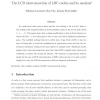Free Online Productivity Tools
i2Speak
i2Symbol
i2OCR
iTex2Img
iWeb2Print
iWeb2Shot
i2Type
iPdf2Split
iPdf2Merge
i2Bopomofo
i2Arabic
i2Style
i2Image
i2PDF
iLatex2Rtf
Sci2ools
PE
2006
Springer
2006
Springer
The LCD interconnection of LRU caches and its analysis
In a multi-level cache such as those used for web caching, a hit at level l leads to the caching of the requested object in all intermediate caches on the reverse path (levels l - 1, . . . , 1). This paper shows that a simple modification to this de facto behavior, in which only the l - 1 level cache gets to store a copy, can lead to significant performance gains. The modified caching behavior is called Leave Copy Down (LCD); it has the merit of being able to avoid the amplification of replacement errors and also the unnecessary repetitious caching of the same objects at multiple levels. Simulation results against other cache interconnections show that when LCD is applied under typical web workloads, it reduces the average hit distance. We construct an approximate analytic model for the case of LCD interconnection of LRU caches and use it to gain a better insight as to why the LCD interconnection yields an improved performance.
Cache | Caching | LCD Interconnection | Optimization | PE 2006 |
| Added | 14 Dec 2010 |
| Updated | 14 Dec 2010 |
| Type | Journal |
| Year | 2006 |
| Where | PE |
| Authors | Nikolaos Laoutaris, Hao Che, Ioannis Stavrakakis |
Comments (0)

